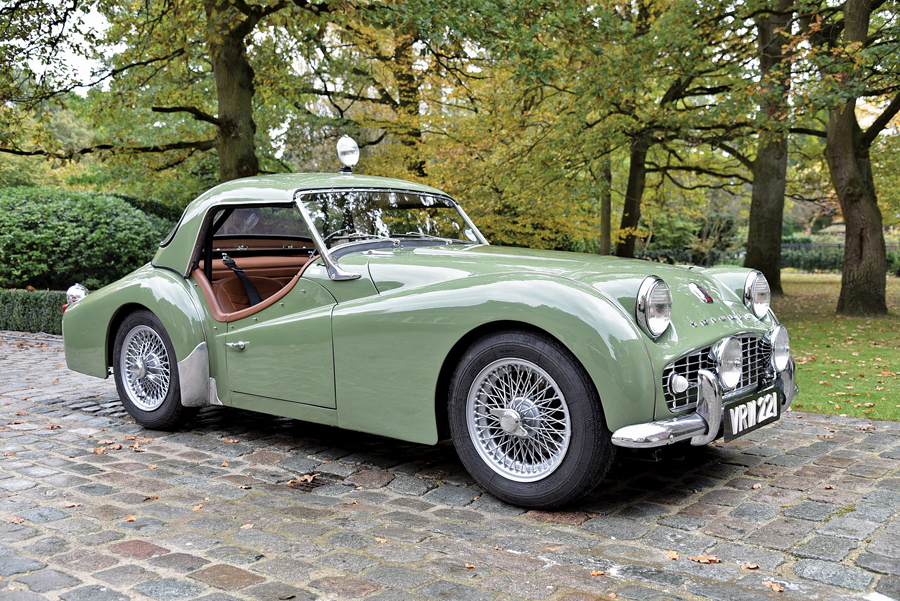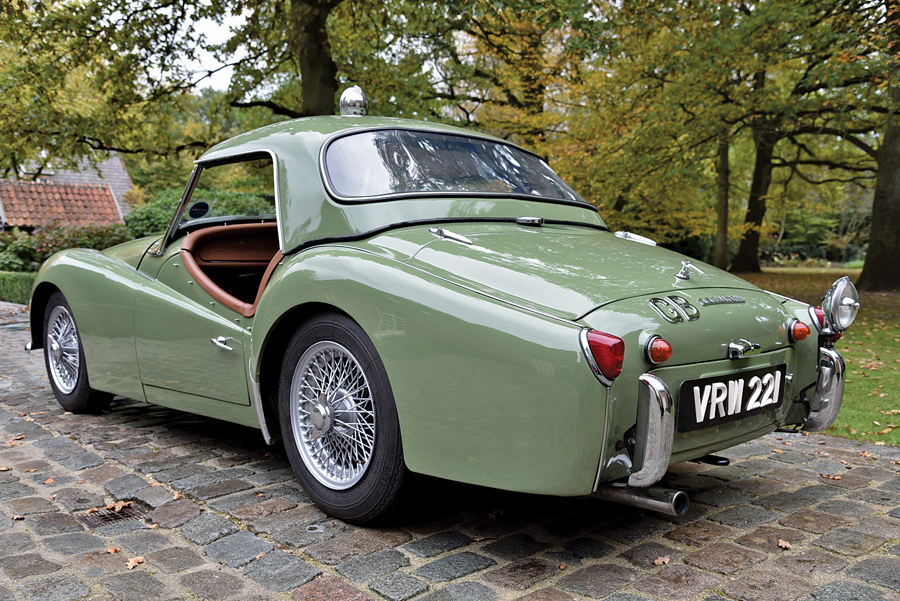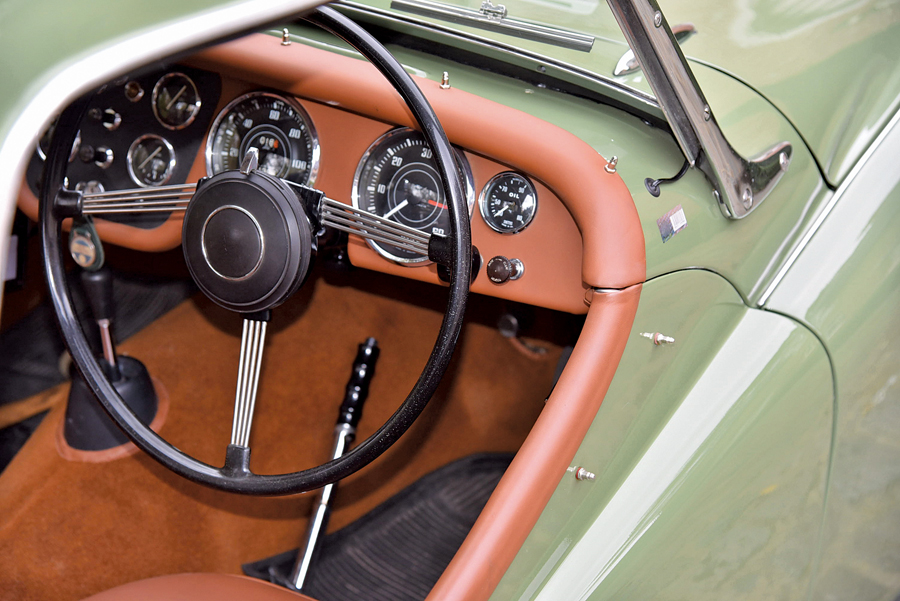SCM Analysis
Detailing
| Vehicle: | 1958 Triumph TR3A Works Rally Roadster |
| Years Produced: | 1957–62 |
| Number Produced: | 58,236 |
| Original List Price: | $2,625 |
| SCM Valuation: | $24,500 (non-Works cars) |
| Tune Up Cost: | $150 |
| Distributor Caps: | £18 ($25) |
| Chassis Number Location: | Plate on scuttle |
| Engine Number Location: | Stamped into block at left rear |
| Club Info: | TR Register |
| Website: | http://www.tr-register.co.uk |
| Alternatives: | 1954–55 Swallow Doretti, 1955–62 MGA 1600, 1959–60 Sunbeam Alpine Series 1 |
| Investment Grade: | B |
This car, Lot 130, sold for $227,019, including buyer’s premium, at RM Sotheby’s auction in Paris, France, on February 7, 2018.
The Triumph Works pensioned off this car after the 1958 season for the simple reason that it was worn out.
Rallies such as the Monte Carlo in the 1950s and 1960s involved long run-ins from far-flung start points such as Glasgow and Oslo before the routes converged and the rallying got technical — on ever-tighter time limits — as the competition approached the Alps.
Picture the washboard hairpins of Mont Ventoux on the Coupe des Alpes — some of the roads would be little more than single-track, with long drops waiting for the unlucky.
A short, hard-knock life
There were no roll cages and no harnesses in those days. The grip from the cross-ply tires was much less than we enjoy from our front-wheel-drive shopping appliances of today, and if you fell off an unfenced hairpin, it could be a long way down.
The attrition rate was always high — there were 265 retirements and only 38 finishers on the 1958 Monte Carlo. The pressure to keep up the pace never went away because arriving at a time control more than 30 minutes late generally meant exclusion from the rally. This is why Waddington pressed on regardless to Monaco to take part in the Driving Tests.
A picture from the event shows our subject car bumperless and with the left front wing slightly bent/wrapped under, so it obviously had a coming-together with some obstacle.
Footage of the time shows drivers gamely continuing with their mounts sometimes missing doors and parts of wings. Less amusingly, there were occasional fatalities.
On the ’58 Tour de France, a 5,935-km event where only 37 of 133 starters reached the finish, Works Jaguar driver and former Le Mans winner Peter Whitehead died after the Jaguar Mk 2 he was sharing with his half-brother Graham — who was at the wheel at the time — plunged off the road near Lasalle and 30 feet down a ravine.
Modern historic events are a little kinder on timing, in that if you go OTL — Over Time Limit — you’re generally only excluded for the day (with a maximum points penalty) and can join in the following morning.
So it was a tough environment for cars and drivers.
Not a lot of special bits
Unlike the Austin-Healey competition, with their triple carburetors, raised side exhausts and special aluminum bodies, Triumph rally cars of that time were basically standard — save for the addition of a pair of spot lights, a hard top and perhaps a light sump guard.
Although we think of separate-chassis TRs as tough old birds, rallying could age them fast. Triumph TR specialist Neil Revington recently completed a historic rally in Portugal with 4 VC, one of the batch of TR4s that followed the TR3s, and he found that he was going through front brake pads in a day and a half.
Although the TR3 had been the first production car to use disc brakes as standard, it was a brake problem that caused the crew of our car (the first Australians to enter the event, by the way) to crash out of the 1958 Tour de France. Their car, numbered 156, was 15th at the time, but former tennis champ Annie Soisbault, navigated by Michèle Cancre, finished 14th in another TR3A, numbered 155, with Ferrari 250 GTs in 5th, 7th and 8th places.
Footage of our subject car on the 1958 Alpine Rally — the first time the Works cars used 2,138-cc engines — shows its front brakes smoking hard at a service stop. Soisbault later crashed her TR3A on a hairpin.
The RM Sotheby’s auction catalog included a charming black-and- white shot of our car on the ’58 Tour de France starting ramp on the Promenade des Anglais in Nice — before it got bent. There was no mention of the extent of the damage, but presumably it was straightened out at the Works before the car was sold into private hands the following year.
Now shiny and restored
At some point, our subject car was restored to a high level.
The body remains straight, and the door fit is pretty good, although there’s a slight step in the front wing-to-sill alignment, which isn’t unusual on these.
The paint is still shiny. The interior leather looks almost unused — although it is lightly wrinkled on the cockpit edgings. The car retains its original factory hard top. Sensibly, a roll bar has been fitted, as it has been used on historic rallies.
The roof-mounted spotlight it usually wore has been refitted, instead of the blanking plate it had for the ’58 Tour. I couldn’t see a sump shield/skid plate in the pictures, so it may have been lost, although it wouldn’t be needed on the gentle type of historic rallies and tours that it’s been entered on in the present ownership.
The engine was stated to be the original, but the catalog writer may have meant “the one it had when Triumph sold it,” as they ran at 2,088 cc
or 2,138 cc, depending on the event rules.
The car appears to have had several keepers — a total of eight by 1990 — when it was pictured on the front cover of Classic Cars.
It was filmed at Castle Combe in 2012 and appeared at a Belgian concours in 2013 — all the while in good cosmetic order. Around this time it passed through the hands of a couple of dealers.
A lot of money for a little competition history
As to values, we don’t see as many Triumph TRs as Healeys at auction, so there’s not much to gauge it by. Still, this felt a lot for a lesser Works car with relatively limited factory competition history.
Fender Broad asked £120k for it in 2013 (then $185k, now $170k).
In 2014 it was with JD Classics and you can be sure the price wouldn’t have gone down. There it fetched €183,000, or £163,000 ($250,000).
A nice, stock TR3A (which this basically is, remember) sets you back about £25k–£27k ($36k–$39k) in its home country right now.
As a comparison, “6 VC,” one of the four mechanically similar TR4s that Triumph ran between 1962 and 1964, is insured for £200k ($280k today), and owner Revington reckons that even if he rolled it into a ball he’d struggle to spend more than £150k ($210k) building a new one to slide under the original chassis plate.
VRW 221 fetched more than that this time, so we’ll call it well sold. But as a real Works car, even with limited factory rally team history, its value is unlikely to go down. ♦
(Introductory description courtesy of RM Sotheby’s.)


